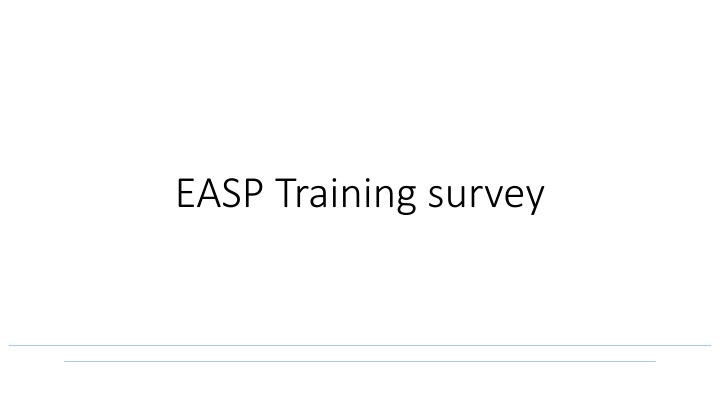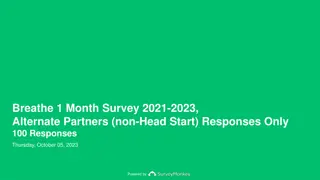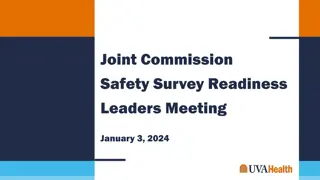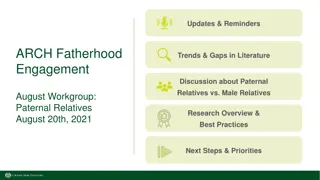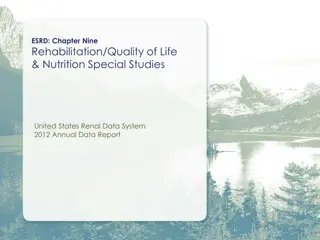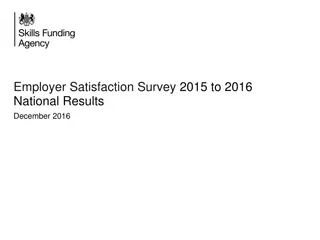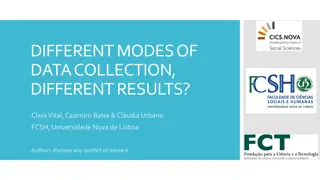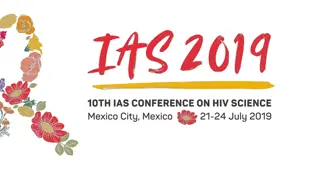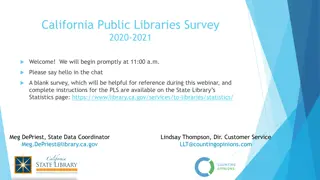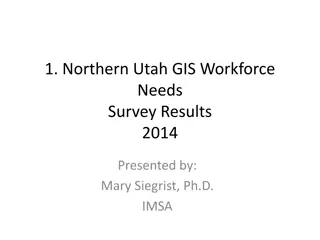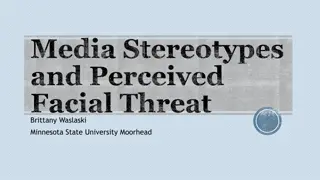EASP Training Survey Sociodemographic and Perceived Needs
This survey explores sociodemographic information such as gender, status, and geographical area of participants, along with perceived training needs in various aspects like science dissemination, research, academic communication, and more. The findings highlight differences based on gender, geographical location, and membership status, providing valuable insights for training strategies.
Download Presentation

Please find below an Image/Link to download the presentation.
The content on the website is provided AS IS for your information and personal use only. It may not be sold, licensed, or shared on other websites without obtaining consent from the author.If you encounter any issues during the download, it is possible that the publisher has removed the file from their server.
You are allowed to download the files provided on this website for personal or commercial use, subject to the condition that they are used lawfully. All files are the property of their respective owners.
The content on the website is provided AS IS for your information and personal use only. It may not be sold, licensed, or shared on other websites without obtaining consent from the author.
E N D
Presentation Transcript
1. Sociodemographic information GENDER STATUS GEOGRAPHICAL AREA male female gender minority post-graduate member full member West EU East EU Non-EU 6% 9% 22% 12% 35% 59% 79% 78% West EU: Austria, Belgium, Denmark, Finland, France, Germany, Iceland, Ireland, Italy, Netherlands, Portugal, Spain, Sweden, Switzerland, United Kingdom East EU: Bulgaria, Croatia, Czech Republic, Hungary, Kosovo, Moldova, Poland, Serbia, Slovakia Non-EU: Australia, India, Israel, Malaysia, New Zealand, Russian Federation, United Arab Emirates, United States 314 participants No significant association between gender, status and geographical area Greece,
2. Perceived Training Needs Key findings: 1. 1. Science dissemination and search for funds Science dissemination and search for funds are the areas in which participants consistently perceive more training needs 2. 2. EU participants report higher needs in science dissemination EU participants report higher needs in science dissemination(similar trend for teaching ) 3. Participants from EAST EU report higher training needs in research , academic communication and search for funds . 4. Postgraduate members report higher training needs on service to the community and teaching 5. 5. Female participants perceive higher needs in "academic communication" Female participants perceive higher needs in "academic communication" (is this a reflection of gender differences in perceived self-efficacy or more difficulties in getting their work accepted in academic journals or conferences? Is this related to the pandemic penalty?)
Please indicate in which of these aspects you think you need to fill gaps in your training gaps in your training teaching teaching 21,50% science dissemination research research 35,50% accademic communication 32,70% search for funds 60,40% service to the community accademic comunication academic work management 21,20% service to the community 27,40% science dissemination 55,10% accademic work management search for funds
Please indicate in which of these aspects you think you need to fill gaps in your training gaps in your training post graduate full teaching post graduate full teaching 34,80% 18% research 42% 33,20% science dissemination research academic communication 53,60% 17,50% search for funds 66,70% 59,40% accademic work management service to the community accademic comunication 24,60% 20,10% service to the community science dissemination 39,10% 24,20% accademic work management 60,90% 52,90% search for funds ?2significant (p<.05) in bold Post-graduate members mentioned more teaching, academic communication and service to the community compared to full members
Please indicate in which of these aspects you think you need to fill gaps in your training gaps in your training male female gender minority male female gender minority teaching teaching 19,80% 22,30% 22,70% research 30,60% 37,80% 40,90% science dissemination research academic communication 23,40% 39,90% 18,20% search for funds 57,70% 63,30% 50,00% service to the community accademic comunication accademic work management 20,70% 21,30% 22,70% service to the community science dissemination 30,60% 26,60% 18,20% accademic work management search for funds 51,40% 60,10% 31,80% ?2significant (p<.05) in bold Female members mentioned more academic communication and science dissemination compared to men and GM
Please indicate in which of these aspects you think you need to fill gaps in your training gaps in your training west EU east EU non-EU teaching west EU east EU non-EU teaching 22,50 22,20 3,80 science dissemination outside university research 33,1 50 30,8 research academic communication 30,9 58,3 19,2 search for funds 60,2 77,8 46,2 accademic work management service to the community academic communication 22,5 22,2 11,5 service to the community science dissemination 31,4 11,1 19,2 academic management work 59,3 52,8 38,5 search for funds ?2significant (p<.05) in bold Academic communication and search for funds are mentioned more in East EU, service to the community is mentioned more in West EU.
3. Training options preferences Key findings: 1. Consistently with what was found on training needs the most selected option across all the participants are related to grant proposal writing and structuring (this is significantly more selected by females and EAST EU participants); social advocacy and communicating science to non-scientist are also highly selected (especially from WEST EU participants) 2. Among the research methods training proposed multilevel data analysis , big data analysis and longitudinal data analysis are more likely to be attended. These option are followed by qualitative methods (especially for participants of gender minority groups) 3. Post-graduate and EAST EU members are likely to attend also academic writing trainings.
In order to plan future training session future training sessions, please indicate which of the following you are likely to attend Post-graduate members Full members I would not find value in any of these options (please I would not find value in any of these options social advocacy (making your research relevant to policy social advocacy (making your research relevant to writing for public audiences writing for public audiences social media and media training social media and media training communicating science to non scientists communicating science to non scientists promoting your research ideas to private stakeholders promoting your research ideas to private stakeholders grant proposal structuring and writing grant proposal structuring and writing preparing effective oral presentations (in different preparing effective oral presentations (in different academic writing academic writing an introduction to social neuroscience an introduction to social neuroscience understanding open science understanding open science qualitative methods qualitative methods big data analysis big data analysis dyadic data analysis dyadic data analysis multilevel data analysis multilevel data analysis longitudinal data analysis longitudinal data analysis experimental design experimental design teaching social psychology teaching social psychology 0% 10% 20% 30% 40% 50% 60% 70% 80% 0.00% 10.00% 20.00% 30.00% 40.00% 50.00% 60.00%
In order to plan future training session future training sessions, please indicate which of the following you are likely to attend Post-graduate members Full members teaching social psychology experimental design longitudinal data analysis multilevel data analysis dyadic data analysis big data analysis qualitative methods understanding open science an introduction to social neuroscience academic writing preparing effective oral presentations (in different contexts/for different audiences) 44% 21,70% 11,10% 33,20% 50% 17,20% 44,30% 27,90% 14,80% 37,70% 39,10% 59,40% 21,70% 49,30% 46,40% 23,20% 14,50% 34,80% 9,80% 13,50% 39,10% 12,70% grant proposal structuring and writing promoting your research ideas to private stakeholders communicating science to non scientists social media and media training writing for public audiences social advocacy (making your research relevant to policy makers) I would not find value in any of these options (please indicate any other topic you would value) 73,90% 49,20% 43,40% 34,40% 60,90% 36,20% 43,50% 43,90% 25% 32,40% ?2significant (p<.05) in bold 53,60% 45,10% 4,30% 6,10%
In order to plan future training session future training sessions, please indicate which of the following you are likely to attend male gender minority female I would not find value in I would not find value in I would not find value in social advocacy social advocacy social advocacy writing for public audience writing for public audience writing for public audience social media and media social media and media social media and media communicating science to communicating science to communicating science to promoting research ideas promoting research ideas promoting research ideas grant proposal structuring grant proposal structuring grant proposal structuring preparing effective oral preparing effective oral preparing effective oral academic writing academic writing academic writing an introduction to social an introduction to social an introduction to social understanding open science understanding open science understanding open science qualitative methods qualitative methods qualitative methods big data analysis big data analysis big data analysis dyadic data analysis dyadic data analysis dyadic data analysis multilevel data analysis multilevel data analysis multilevel data analysis longitudinal data analysis longitudinal data analysis longitudinal data analysis experimental design experimental design experimental design teaching social psychology teaching social psychology teaching social psychology 0.00% 10.00% 20.00% 30.00% 40.00% 50.00% 60.00% 0.00% 10.00% 20.00% 30.00% 40.00% 50.00% 60.00% 0.00% 20.00%40.00%60.00%80.00% Significant differences for qualitative measures and for the not find value in anything proposed item (mentioned more by gender minorities), as well as for grant proposal and structuring (mentioned more by females)
In order to plan future training session future training sessions, please indicate which of the following you are likely to attend male female gender minority teaching social psychology experimental design longitudinal data analysis multilevel data analysis dyadic data analysis big data analysis qualitative methods understanding open science an introduction to social neuroscience academic writing* preparing effective oral presentations (in different contexts/for different audiences) grant proposal structuring and writing promoting your research ideas to private stakeholders communicating science to non scientists social media and media training writing for public audiences social advocacy (making your research relevant to policy makers) I would not find value in any of these options (please indicate any other topic you would value) 22,50% 13,50% 34,20% 49,50% 15,30% 46,80% 21,50% 12,60% 29,30% 19,70% 36,70% 54,30% 19,70% 46,30% 36,70% 18,60% 27,80% 11,10% 27,80% 55,60% 22,20% 38,90% 50% 16,70% 8,10% 11,70% 12,80% 21,80% 5,60% 22,20% 15,30% 20,70% 11,10% 45,00% 61,20% 44,40% ?2significant (p<.05) in bold 40,50% 36,70% 16,70% 42,30% 22,50% 33,30% 52,10% 31,90% 37,20% 38,90% 22,20% 33,30% * ?2(p=.09) 39,60% 52,70% 44,40% 7,20% 4,30% 22,20%
In order to plan future training session future training sessions, please indicate which of the following you are likely to attend west EU non-EU east EU I would not find value in I would not find value in I would not find value in social advocacy social advocacy social advocacy writing for public audience writing for public audience writing for public audience social media and media social media and media social media and media communicating science to communicating science to communicating science to promoting research ideas promoting research ideas promoting research ideas grant proposal structuring grant proposal structuring grant proposal structuring preparing effective oral preparing effective oral preparing effective oral academic writing academic writing academic writing an introduction to social an introduction to social an introduction to social understanding open science understanding open science understanding open science qualitative methods qualitative methods qualitative methods big data analysis big data analysis big data analysis dyadic data analysis dyadic data analysis dyadic data analysis multilevel data analysis multilevel data analysis multilevel data analysis longitudinal data analysis longitudinal data analysis longitudinal data analysis experimental design experimental design experimental design teaching social psychology teaching social psychology teaching social psychology 0.00% 10.00% 20.00% 30.00% 40.00% 50.00% 60.00% 0.00% 10.00% 20.00% 30.00% 40.00% 50.00% 60.00% 0.00% 20.00% 40.00% 60.00% 80.00% 100.00% Significant differences for multilevel data analysis and grant proposal structuring and writing (mentioned more in East EU), as well as for communicating science outside academia, social media training and social advocacy (mentioned more in West EU)
In order to plan future training session future training sessions, please indicate which of the following you are likely to attend West EU East EU Non-EU teaching social psychology experimental design longitudinal data analysis multilevel data analysis dyadic data analysis big data analysis qualitative methods understanding open science an introduction to social neuroscience academic writing preparing effective oral presentations (in different contexts/for different audiences) grant proposal structuring and writing promoting your research ideas to private stakeholders communicating science to non scientists social media and media training writing for public audiences social advocacy (making your research relevant to policy makers) I would not find value in any of these options (please indicate any other topic you would value) 27,10% 15,70% 34,70% 52,10% 17,80% 45,30% 32,20% 15,70% 30,60% 27,80% 47,20% 72,20% 22,20% 47,20% 36,10% 22,20% 15,40% 19,20% 26,90% 38,50% 11,50% 50,00% 26,90% 11,50% 11,90% 16,50% 8,30% 30,60% 0,00% 15,40% 17,80% 19,40% 15,40% 53,40% 77,80% 30,80% 40,70% 25,00% 30,80% 53% 42% 27% 31,40% 38,10% 16,70% 33,30% 11,50% 26,90% ?2 significant (p<.05) in bold 50,80% 38,90% 26,90% 15,40% 5,60% 15,40%
